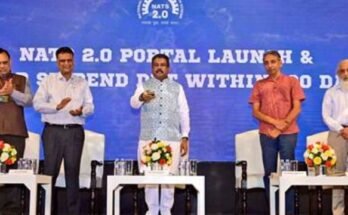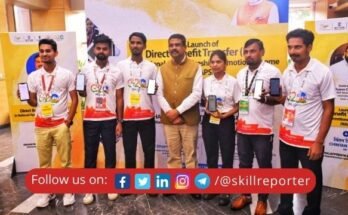Cuttack : The Directorate of Technical Education & Training, Odisha through its notification No : 4360 invites Technical and Financial Proposals from Agencies of national and international repute for the establishment of State Apprenticeship Monitoring Cell as specified in this RFP Document
The RFP document can be downloaded from Business Section on www.SkillReporter.com ( Click Here to download ) the website link www.dtetodisha.org with effect from 04.03.2019 (11 AM) to 18.03.2019 (2 PM) or from here and response to this tender shall be deemed to have been done after careful study and examination of this document with full understanding of its implications.
Interested agencies are requested to submit the details to the undersigned as per the schedule indicated in the Fact Sheet, by post (Registered / Speed/ Courier) at the office of the Directorate of Technical Education & Training, Odisha. Based on the eligibility criteria as mentioned in the RFP (Click Here to download ), the applicant agency will be selected.
Background
Apprenticeship training is one of the most effective schemes to develop skilled manpower in terms of quality of training, experiential learning and the enhanced employability. The National Policy of Skill Development and Entrepreneurship 2015, launched by the Hon’ble Prime Minister on 15th July, 2015, focuses on apprenticeship as one of the key program for creating skilled manpower in India. The policy proposes to proactively work with industry including MSME sector to facilitate a tenfold increase in apprenticeship opportunities in the country by 2020. The Apprentices Act, 1961 was enacted with the objective of regulating the program of training of apprentices in the industry by utilizing the facilities available therein for imparting on-the-job training. Presently about 2 lakh trainees are annually enrolled in the ATS in about 28,500 establishments which is in the order of about 0.05% of India’s workforce. The government has brought comprehensive amendments in the Act in December 2014 to make it more attractive for both industry and youth. Major changes introduced in the amendment are: replacing the outdated system of trade wise and unit wise regulation of apprentices with a band of 2.5% to 10% of the total workforce (including contractual workers), introduction of optional trades, removing stringent clauses like imprisonment & allowing industries to out-source basic training. With the introduction of ‘optional trades’ companies can now design needs-based apprenticeship programs and are permitted to involve a third-party training provider to run basis training modules. New “dual” training programs have been developed and ITI and companies are encouraged to deliver dual training.
Objectives of the Proposal
Ministry of Skill Development and Entrepreneurship has targeted to enhance the engagement of both trade and optional trade apprentices from existing 2.3 lakh to 50 lakh cumulatively by 2020. To meet this challenging task of increasing enrollment of trainees and establishments under the apprenticeship system, DGT, New Delhi has considered to strengthen the State Government and UT administration by providing a functional implementation and monitoring cell at the State/UT level.
Refer SkillReporter (www.SkillReporter.com) for skill development and The Edupress (www.TheEduPress.com ) for education related important News, Tenders, RFP, Jobs, EOI, Events, Announcements, Circulars, Notices and other useful updates. Content also shared on Facebook Twitter Linkedin
At present, the apprenticeship cell of DTE&T, Odisha has been functioning with one Joint Apprenticeship Advisor, one Deputy Apprenticeship Advisor and ministerial staff under the supervision of DTE&T – cum – SAA. The Government ITI Principals act as Zonal Apprenticeship Advisers for implementation of the Scheme.
In order to effectively operate and monitor NAPS in the State in an augmented manner through wider participation of MSMEs, there is absolute need to establish State Apprenticeship Monitoring Cell (SAMC) at the Directorate.
Scope of Work
The SAMC would be the key agent for driving apprenticeship development and innovation in the state, and managing the state level functions in the National Apprenticeship Training Scheme and state apprenticeship initiatives.
The function of the Cell can be divided into following broad areas:
a. Sensitization and Awareness creation of stakeholders in order to promote participation in apprenticeship training and assist stakeholders in getting involved:
i. Be the advocates for modern apprenticeship training in the states
ii. Sensitize and inform stakeholders (business community, youth/families, unions, etc) about the benefits of apprenticeship training
iii. Inform stakeholders about options and rules/regulations of apprenticeship training and its various support schemes in India and the state
iv. Organize and facilitate the establishment of an “apprenticeship champions” network and its activities
v. Provide information and counseling to industry clusters and individual firms intending to start apprenticeship training
vi. Liaise with ITIs and other training providers with the aim of supporting their engagement in dual apprenticeship training
vii. Create platforms for information exchange and regular dialogue with schools/institutions to enhance local awareness about apprenticeship training and the relevant schemes
viii. Organize innovative outreach programmes to target schools directly; student exposure visits to industries, bring on board successful apprentices as potential brand ambassadors
ix. Organize Awareness campaigns through social media – FB, print, radio, mobile platforms etc
x. Identify existing mechanisms for outreach including channels that are already available and address gaps and areas to build up capacity
xi. Develop and implement activities ensuring the enrollment of women particularly in the non-traditional sectors, SC & ST and persons with disabilities in the apprenticeship scheme
xii. Conduct all other activities necessary and conducive to increase participation and improve quality of apprenticeship training in the state
b. Facilitate the implementation of apprenticeship support schemes, such as STRIVE, NAPS Scheme, and others
i. Advertise the IAI Grant Scheme and other schemes for the promotion of apprenticeship training among companies and industry clusters in the state
ii. Manage for the STRIVE IAI grant scheme the call for proposals in the state
iii. Facilitate partnerships between industry cluster/business associations, basic training providers and possibly Third Party Accelerators (TPA) with the aim of initiating apprenticeship initiatives
iv. Facilitate the involvement of external experts in the development of apprenticeship initiatives where appropriate
v. Support industry clusters to conceptualize industry apprenticeship initiatives and to apply for grant funding
vi. Support industry clusters in the implementation of industry apprenticeship initiatives (hand-holding approach)
vii. Facilitate capacity development needs assessments for apprenticeship training in companies and basic training providers
viii. Facilitate the participation of apprenticeship stakeholders in the state in capacity building activities funded under STRIVE and other schemes and programs
ix. Assist companies to access subsidies under the NAP Scheme
x. Operationalize and manage activities to facilitate the enrollment and intake of applicants from the ITI database expanding the candidate base to include fresher, PMKVY and MES candidates prescribed under the NAP Scheme, e.g. through setting up a student’s help-line.
c. Monitoring of apprenticeship training in the state
i. Oversee the collection of relevant management information data for apprenticeship training in the state (using the central apprenticeship portal)
ii. Undertake activities to ensure apprenticeship information in the state is entered into the central apprenticeship portal
iii. Compile annually information about apprenticeship activities in the state, and disseminate information to the relevant state offices and stakeholders
iv. Assist the implementation of studies and evaluations of ATS in India in the state
v. Monitor the implementation of supported Industry Apprenticeship Initiatives and verify achievement of results and milestones
vi. Facilitate and oversee state-level evaluations of ATS issues in the state as needed.
d. Implementation of all deliverables envisaged in the revised guidelines issued by DGT, New Delhi vide letter No DGT-1(27)/D1/SAMC/2017-AP dated26.12.2018 in Connect-Bridge-Execute mode.
Important Dates :
Last date for receipt of Technical and Financial proposals (Sealed Envelope) : 10 th April 2019 (2 PM)
Opening of Technical proposals 10 th April 2019 (4 PM)
Technical Presentation 15 th April 2019 (11 AM)
Opening of Financial proposals of applicants who qualify pre-qualification (technical) criteria : 18 th April 2019 (11 AM)
Letter of Award : To be intimated to selected Agency
Start Date : To be intimated to selected Agency
Method of Selection : QCBS (70:30)
Contact Details
Directorate of Technical Education & Training, Odisha
Killa Maidan, Buxi Bazar, Cuttack – 753001
Phone: 0671-2301061
dtetorissa@gmail.com
For eligibility criteria, application formats and other important information, refer RFP Document (to download, Click Here)



